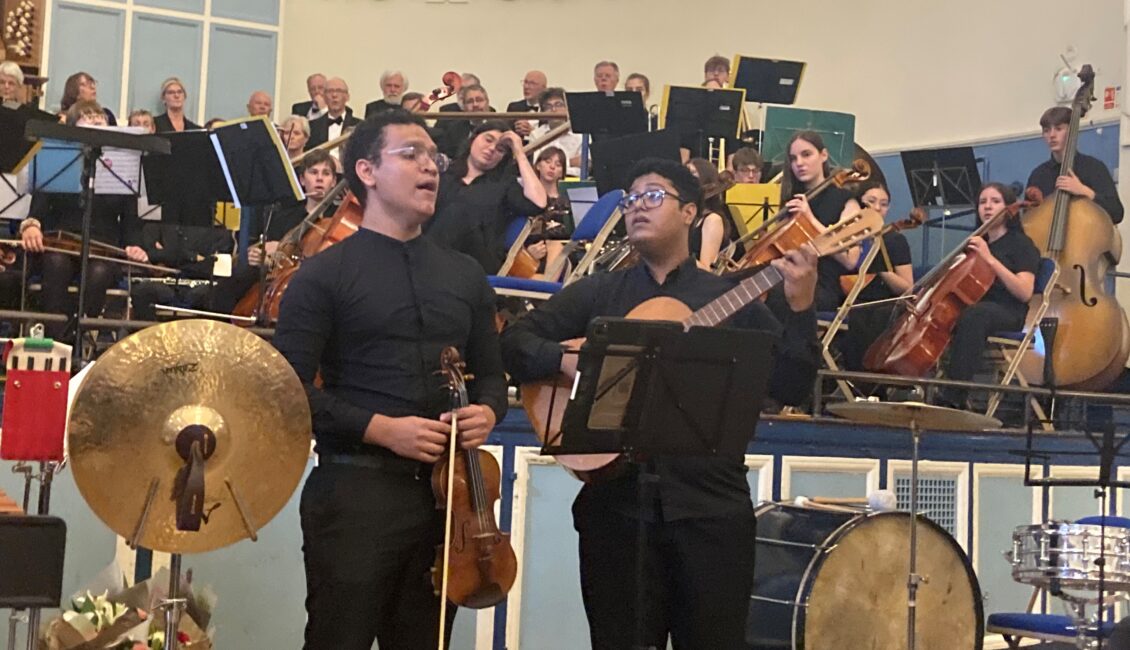
“The wheel of fortune turns”. With these words, sung by the choir early in Carl Orff’s deservedly popular cantata Carmina Burana, the audience is introduced to one of the simplest yet most universal truths about the human condition. Because of the immediately engaging and thrilling music, setting racy texts from around eight hundred years ago, every performance is something of an event in itself.
This one was special for an additional reason: Oxford Town Hall welcomed young people from several of the city’s twin towns, joining together under John Lubbock’s masterly direction to become the extremely large orchestra required. They came, as the Lord Mayor’s introduction informed us, from Bonn Leiden, Leon, Padua, Wroclaw and Perm, united in showing that music can transcend national boundaries and bring people together for the common good – a message as vital today as ever.
Before the work’s resounding opening chords, however, came two surprises. The Dutch contingent had brought with them the score of a splendid piece, ‘Millennium’, which the entire orchestra had learned in the week of rehearsals leading up to this festive occasion. This proved a triumphant opening to the concert, a proper overture with Walton-like fanfares and a rich, noble second subject for violas and cellos in particular, almost a film score in itself.
The second surprise was the appearance in front of the stage of two outstanding Nicaraguan musicians, César Moreira and José Perez on cello and violin, both studying music teaching, and both leading their respective sections of the orchestra. Yet this evening they wore different hats – singing, with beautifully blended voices over a guitar accompaniment, two delightful folk songs from Nicaragua and Costa Rica, before seamlessly breaking into Leonard Cohen’s ‘Hallelujah’, joined gently in the choruses by what seemed like the whole audience. What a powerful message that sent out in itself.
And then came the familiar, resounding explosion of the opening movement of Carmina Burana. The work rests on powerful rhythms, sometimes unexpected, always hypnotic, and the choir worked valiantly to rise to those challenges. The first main section, ‘In Spring’, was given suitably bucolic treatment by the sopranos and altos in their movement reflecting “the merry face of spring”, fading away with appropriate wistfulness as if to emphasise the ephemeral nature of the season. The tenors (would that there had been even more of them, especially in ‘Ecce gratum’) and basses came into their own in the second section, ‘In the Tavern’, working exceptionally hard to project the text (there’s a lot of it!) and clearly enjoying their stand-out moment recounting the absurdly long list of drinkers in ‘Bibit hera, bibit herus’. The libretto throughout may be in secular Latin, Middle High German or Old French, but the choir, though sometimes drowned out by the huge orchestral forces, sang as though they not only understood it, but meant it. This was particularly effective in their final chorus of the third section, ‘In the Court of Love’, where Lubbock’s energetic direction pulled the choir successfully through the dramatic accelerando at “novus, novus amor est, quo pereo”.
The four soloists have demanding roles. Vocally they played their parts to perfection: Daniel Barrett’s resonant parody of the decadent abbot, Dominic Bevan’s suitably anguished, tortuous portrayal of the roasting swan, and the sopranos Belinda Gifford-Guy and Hannah Davey rising (literally) to ethereal heights in their arias, not least in the quasi-erotic ‘Dulcissime’ or ‘In trutina’, although the solo in ‘Stetit puella rufa tunica’ lacked the delicacy that the movement calls for. Unfortunately, the soloists were all located in the upstairs side gallery, completely invisible to large sections of the audience.
The stars of the evening, of course, were the young members of this international orchestra who had come together only days before, on arrival in Oxford. There were many outstanding solos and ensemble moments, including from flute and trombones, and the violin front desk, while the percussion section were having the time of their lives. As an orchestra, they excelled. The dance section of ‘In the Meadow’ was characteristically lively, with sharp, relentless rhythm and an exuberance that in fact reflected the orchestra’s total commitment throughout. By contrast the quieter, pensive sections such as the ‘Round dance/Reie’ were intimate and sensitive. It would be easy to underestimate the achievement of these young players, and of their encouraging, cajoling, crystal-clear conductor, John Lubbock, who coaxed from them both roof-raising, blistering symphonic sound and contrasting chamber-music intimacy as required, while allowing them full freedom to give the final, unforgettable climax their all. And how the audience loved it!
On the world stage, the European Youth Orchestra and the West-Eastern Divan Orchestra have shown us the power and symbolism of musicians coming together from different backgrounds in a common, inspiring endeavour. This performance of Carmina Burana by young musicians from some of Oxford’s twin cities will stand as a beacon of hope for the future. Let us hope for future similar occasions, and for the further expansion of the work of Oxford International Links. Long may twinning music of such quality flourish!
John Dunstan Daily Info 15 July 2024





